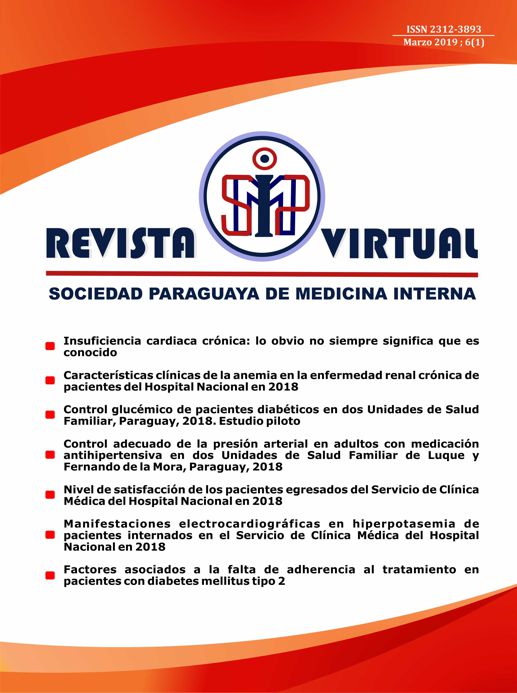Manifestaciones electrocardiográficas en pacientes con hiperpotasemia del Servicio de Clínica Médica del Hospital Nacional en 2018
Resumen
Introducción: el aumento sérico del potasio >5,5 mEq/L constituye la alteración electrolítica grave pues puede generar alteraciones en la conducción cardiaca y arritmias potencialmente letales. El electrocardiograma es una fuente fiable para determinar la hiperpotasemia.
Objetivos: describir los trastornos electrocardiográficos en pacientes internados en el Servicio de Clínica Médica del Hospital Nacional en 2018.
Metodología: estudio observacional, transversal, prospectivo de una base de datos secundaria. Se relacionaron los electrocardiogramas y niveles séricos del potasio en varones y mujeres, mayores de edad, con potasio sérico >5,5 mEq/L internados en Servicio de Clínica Médica del Hospital Nacional (Itauguá, Paraguay) en el periodo agosto-diciembre 2018.
Resultados: se incluyeron 43 pacientes, 51% varones con edad media 60±13 años y 49% mujeres con edad media 57±14 años. Eran portadores de insuficiencia renal crónica en 91%. El valor medio del potasio sérico fue 6,5±0,8 mEq/L. En 18 sujetos (42%) se detectó alguna alteración electrocardiográfica compatible con hiperpotasemia. Los hallazgos más comunes fueron onda T picuda (21%), índice T/R >0,75 (14%) y bradicardia sinusal (5%).
Conclusión: los trastornos electrocardiográficos se detectaron en 42% y el hallazgo más frecuente fue la onda T picuda (21%).
Citas
2. Khodorkovsky B, Cambria B, Lesser M, Hahn B. Do hemolyzed potassium specimens need to be repeated? J Emerg Med. 2014; 47(3):313–7.
3. Kovesdy CP. Management of hyperkalaemia in chronic kidney disease. Nat Rev Nephrol. 2014; 10(11):653–62.
4. Montford JR, Linas S. How dangerous is hyperkalemia? J Am Soc Nephrol. 2017; 28(11):3155–65.
5. Siniorakis E, Arvanitakis S, Psatheris G, Flessas N, Prokovas E, Exadactylos N. Hyperkalaemia, pseudohyperkalaemia and electrocardiographic correlates. Int J Cardiol. 2011; 148(2):242–3.
6. Irizar-Santana S, Kawano-Soto CA, Dehesa López E, López-Ceja M. Hiperkalemia: Artículo de revisión. Rev Med UAS. 2016;6(3):142–66.
7. Johri AM, Baranchuk A, Simpson CS, Abdollah H, Redfearn DP. ECG manifestations of multiple electrolyte imbalance: Peaked T wave to P wave (“Tee-Pee Sign”). Ann Noninvasive Electrocardiol. 2009;14(2):211–4.
8. Zarowitz BJ, Lefkovitz A. Recognition and treatment of hyperkalemia. Geriatr Nurs. 2008;29(5):333–9.
9. Rossignol P, Legrand M, Kosiborod M, Hollenberg SM, Peacock WF, Emmett M, et al. Emergency management of severe hyperkalemia: Guideline for best practice and opportunities for the future. Pharmacol Res. 2016; 113(Pt A):585–91.
10. Viera AJ, Wouk N. Potassium disorders: hypokalemia and hyperkalemia. Am Fam Physician. 2015; 92(6):487–95.
11. Berkova M, Berka Z, Topinkova E. Arrhythmias and ECG changes in life threatening hyperkalemia in older patients treated by potassium sparing drugs. Biomed Pap Med Fac Univ Palacky Olomouc Czech Repub. 2014;158(1):84–91.
12. Lim S. Approach to hyperkalemia. Acta Med Indones. 2007; 39(2):99–103.
13. Chon SB, Kwak YH, Hwang SS, Oh WS, Bae JH. Severe hyperkalemia can be detected immediately by quantitative electrocardiography and clinical history in patients with symptomatic or extreme bradycardia: A retrospective cross-sectional study. J Crit Care. 2013;28(6):1112.e7–1112.e13.
14. Kuntjoro I, Teo SG, Poh KK. Abnormal ECGs secondary to electrolyte abnormalities. Singapore Med J. 2012;53(3):152–6.
15. Petrov DB. An electrocardiographic sine Wave in hyperkalemia. N Engl J Med. 2012; 366(19):1824.
16. Park Y, Shin S, Hwang HJ. Panoramic change of transient hyperkalemia on electrocardiogram. Eur Heart J. 2013; 34(14):1030.
17. Durfey N, Lehnhof B, Bergeson A, Durfey SNM, Leytin V, McAteer K, et al. Severe hyperkalemia: Can the electrocardiogram risk stratify for short-term adverse events?. West J Emerg Med. 2017;18(5):963–71.
18. Nemati E, Taheri S. Electrocardiographic manifestations of hyperkalemia in hemodialysis patients. Saudi J kidney Dis Transpl. 2010;21(3):471–7.
19. Gilligan S, Raphael KL. Hyperkalemia and hypokalemia in CKD: Prevalence, risk factors, and clinical outcomes. Adv Chronic Kidney Dis. 2017; 24(5):315–8.
20. Denes P, Garside DB, Lloyd-Jones D, Gouskova N, Soliman EZ, Ostfeld R, et al. Major and minor electrocardiographic abnormalities and their association with underlying cardiovascular disease and risk factors in Hispanics/Latinos (from the Hispanic Community Health Study of Latinos). Am J Cardiol. 2013;112(10):1667–75.
21. Green D, Green HD, New DI, Kalra PA. The clinical significance of hyperkalaemia-associated repolarization abnormalities in end-stage renal disease. Nephrol Dial Transplant. 2013;28(1):99–105.
22. Blair HA. Patiromer: A review in hyperkalaemia. Clin Drug Investig. 2018; 38(8):785–94.
23. Dillon JJ, DeSimone CV, Sapir Y, Somers V, Dugan JL, Bruce CJ, et al. Noninvasive potassium determination using a mathematically processed ECG: Proof of concept for a novel “blood-less, blood test.” J Electrocardiol. 2015; 48(1):12–8.
24. Levis JT. ECG diagnosis : Hyperkalemia. Perm J. 2013;17(1):69.
25. Levis JT. ECG diagnosis: Hyperacute T waves. Perm J. 2015;19(3):79.
26. Wong R, Banker R, Aronowitz P. Electrocardiographic changes of severe hyperkalemia. J Hosp Med. 2011;6(4):240.
27. Koshkelashvili N, Lai JYK. Hyperkalemia after missed hemodialysis. N Engl J Med. 2016; 374(23):2268.
28. Vandael E, Vandenberk B, Vandenberghe J, Willems R, Foulon V. Risk factors for QTc-prolongation: systematic review of the evidence. Int J Clin Pharm. 2017;39(1):16–25.
29. Uvelin A, Pejaković J, Mijatović V. Acquired prolongation of QT interval as a risk factor for torsade de pointes ventricular tachycardia: a narrative review for the anesthesiologist and intensivist. J Anesth. 2017; 31(3):413–23.

















